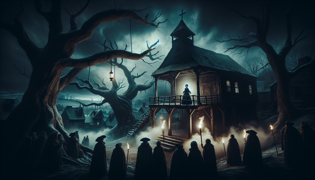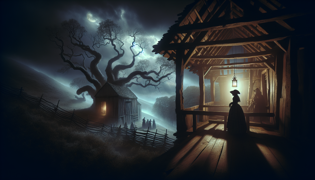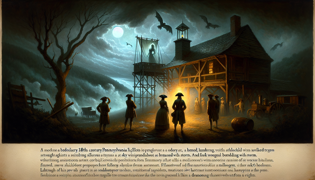The Spirit of Mary Modie Northern Theater
Reading Time: 9 min

About Story: The Spirit of Mary Modie Northern Theater is a Legend Stories from united-states set in the 18th Century Stories. This Dramatic Stories tale explores themes of Good vs. Evil Stories and is suitable for Adults Stories. It offers Cultural Stories insights. A Pennsylvania Witch’s Curse Haunts Barz Hill.
Introduction
Barz Hill looms over the Allegheny frontier like a bruised heart beneath a darkening sky. In the year of our Lord 1758, villagers whispered of Mary Modie—a woman whose pale eyes glowed with defiance beneath the courthouse gallows. By gum, the townsfolk said she bore a secret older than the pines: a pact with forces beyond mortal reckoning. When the sheriff’s men bound her arms and led her through the muddy lantern-lit streets, the scent of damp earth mingled with the bitter tang of fear. A hush settled upon the gathered crowd, heavy as a lead blanket, before the wind swooped in with a wail as hollow as a ghost’s lament.
Condemned for witchcraft, Mary’s final words slipped through the breeze, sharp as icicles: "May your night brood dark, and your souls never find rest." That curse clung to the hill like spider silk, invisible yet unyielding. Wood shutters rattled on moonless eves, and frantic whispers spoke of shadowy apparitions drifting among the rafters of the Northern Theater. Some swore they heard a woman’s laughter echo through the wings—half-chant, half-scream—while others found their blankets soaked with a sudden chill. It was said her spirit prowled overhead, her wide-brimmed hat tipped low, eyes blazing with spite.
Here begins an immersive retelling of the terror Mary Modie unleashed, a cultural echo that lingers like the smokey aroma of a dying hearth. Step softly and listen for her footsteps; the boards creak underfoot like a dying man’s last breath. Over yonder in the gulch, reeds whisper with her name, and the forest moans in sympathy. This is a tale of injustice clad in moonlight’s shroud—a story meant to be remembered whenever dusk falls and a hollow wind sighs through Barz Hill’s sentinel pines.
Trial by Flames and the Birth of a Curse
The courthouse square buzzed with nervous voices, carried on the hiss of winter’s first northerly wind. Wood smoke mingled with the coppery scent of blood from the sharpening of axes. Mary Modie stood at the block, her fingertips numb from frost and indignation. As the magistrate declared her cursed by the Devil, a hush fell, as thick and unyielding as a woolen cloak. A flicker from the nearby torches cast her shadow tall upon the timbered walls, twisting it into monstrous shapes that seemed to leer at the assembly.

She raised her chin, frost glinting on her lashes like spiked beads, and locked eyes with the sheriff. "I did not harm the children," she insisted, voice steady as autumn leaves skittering across the barn floor. A chant rose from the crowd, breaking her words like a sudden gust ripping through a ragged sail. The magistrate’s gavel struck, and the mob surged forward, breath swirling in clouds like spectral dancers in an invisible ballroom. Mary’s wrists, bound by coarse hemp rope, cut into her flesh with a smell of iron and despair. She gazed skyward, where horned clouds gathered, pregnant with storm.
No sooner had the priest intoned the rite of condemnation than Mary’s defiant cry split the air: "Your fear is my inheritance!" The gallows boards creaked beneath her weight as she stepped forward, five heartbeats before the hangman placed the noose. Her cloak—rough-spun wool flecked with remnants of twilight—slipped from her shoulders, tumbling like a wounded raven into the straw-strewn dirt. Then, in a final moment of stillness as cold as tombstone marble, her body swayed and came to rest. A hush followed, broken only by distant thunder rolling through the theater seats like a wounded beast. Villagers scattered, leaving the rising smoke to curl upward in lonely spirals, carrying the first tendrils of Mary’s wrath up to the heavens.
The Haunting of Northern Theater
Within weeks, the wooden shell of the Northern Theater stood half-built at the summit of Barz Hill. Its bare rafters reached skyward like skeletal fingers tearing at the low-hanging clouds. Carpenters spoke of tools vanishing between dawn and dusk, only to reappear encrusted with a powdery white dust that smelled faintly of lilac and decay. On opening night, the whisper of Mary’s curse wreathed the stage wings, caressing the actors’ necks like an unseen hand.

Hank Miller, the theater’s stagehand, recalled a low hum that resonated through the floor planks whenever he crossed from one end to the other. "It sounded like a mother’s lullaby sung backward," he said, voice trembling with recollection. A rotten-wood tang filled the air, as if pages of an old grimoire had been scattered and ground under heel. When the candles flickered and guttered, Mary’s form would glide past the proscenium arch—her bonnet rim casting a raven-dark shadow that swallowed the painted backdrop. Townsfolk claimed her laughter danced on the rafters like drops of ice in a copper pan, each echo snapping a string loose in the pit.
Sometimes, audience members felt a chill burn down their spines, followed by a sudden warmth as though Mary’s breath had passed over them—an unholy benediction left in frost then fire. Children insisted they saw her perched in the balcony, silhouette outlined by moonbeams, lips curled into a cruel smirk. The wood slats creaked in syncopation with their heartbeats, a joined rhythm that defied explanation. On those nights, rehearsals stalled; actors swore their scripts rearranged themselves overnight, lines scratched out or replaced with arcane symbols that glowed faintly by candlelight.
When the impresario, Mr. Josiah Barnes, tried to banish rumor with coin, he found his purse emptied each dawn, the coins stacked in neat pyramids atop the ticket desk. Each silver piece bore an imprint of a weeping woman’s face—Mary’s face, lips parted in silent condemnation. By gum, the theater’s promise of merriment curdled into dread; seedling excitement wilted under the weight of ancestral fear. Yet even as carpenters refused to raise a final shingle and patrons turned away, Mary’s legend only deepened, binding the hill in chains of superstition and dark remembrance.
Confrontation Beneath the Moonlit Pines
A decade passed before three determined souls ventured back to Barz Hill: Esther Quinn, a healer versed in old folk remedies; Jacob Peters, a former soldier haunted by nightmares of war; and Caleb Whitby, the theater’s last surviving carpenter. Their pact formed in a candlelit tavern across the river, where the hearth’s smoky aroma mingled with the sour tang of pine resin. They were drawn by stories of shrieking lights and rattling chains in the theater’s bowels, by Mary’s laughter—sharp as a scythe’s edge—echoing among derelict benches.

Under a waning gibbous moon, they climbed the rugged slope, the earth crunching beneath boots like brittle bones. The hush of the forest perched on their shoulders, made heavier by the creeking hoots of distant owls. Esther paused, dipping her fingers into a pouch of dreamroot tincture; its scent was musky, sweet, and capable of coaxing phantoms from shadowed cupboards. She anointed Jacob’s brow, and the firelight danced in his pale eyes as he exhaled a prayer—an old Pennsylvania Dutch charm, murmured under breath.
Inside the theater, the trio discovered traces of Mary’s presence everywhere: footprints scorched into the stage floor, wisps of silver hair snagged on nails, and a distant lullaby that hummed through the cracks in the boards like a wounded bird’s song. Caleb traced his hand along a beam, catching on a splinter as cold as marble. The rough wood tasted of ancient secrets, its grooves holding the memory of every curse uttered beneath it. Then came the unmistakable clicking of iron links, like a hidden music box winding open somewhere above their heads.
Summoning courage as fierce as a storm in spring, Esther shattered a vial of blessed water at the proscenium’s threshold. The droplets hissed on impact, filling the rafters with the acrid tang of sanctity. Mary’s laughter broke into a shriek that rattled the theater’s core, as if the building itself had exhaled in pain. From the shadows, her ghost emerged in full form—bonnet crushed, cloak tattered like moth-eaten tapestry, eyes burning with mortal grief and righteous fury. Jacob stepped forward, reciting the charm with growing resolve, while Caleb brandished an iron horseshoe, heated in the forge’s dying embers. The two advanced, each step crumbling the darkness around them, until Mary’s form flickered, waned, and at last dissipated into motes of ember-light. The rafters groaned, then fell silent, as though Barz Hill itself exhaled relief.
Conclusion
As the first pale light of dawn brushed Barz Hill’s summit, the Northern Theater lay hushed, its curse lifted at last. The timbered rafters, once echoing with ghostly laughter, creaked solemnly in welcome of a new age. Word of Mary Modie’s passing spirit spread downstream, carried in the reeds and murmured by fishermen casting nets at sunrise. In the years that followed, the theater was completed and repurposed—a place of laughter and music rather than dread. Yet even now, when wind rattles the windowpanes and the moon rises low, some swear that a soft voice drifts into the hall, half-song, half-sigh.
They say that a single lone candle will gutter in the darkest corner, and the scent of rotting pine will stir memories of that long-ago night. In quiet moments, an actor brushing past the proscenium may feel a fleeting chill, as though Mary Modie’s grief still lingers in the woodgrain. But her vengeance has at last given way to rest, the final stitch in a story wound tight by injustice, courage, and the unbreakable bonds of communal faith. Beneath the lantern light, the villagers whisper "anywheres but here," recalling how fear can warp truth until it becomes a thing that will not die. May we remember Mary’s tale not as a warning of witches, but as a testament to the human heart’s capacity for both cruelty and compassion. Good night, Barz Hill—your chapter is closed, yet forever etched in the flicker of every stage candle that burns to defy the dark.
( )
This legend remains a living testament to Pennsylvania’s frontier heritage, reminding each generation that shadows walk with us always—and that sometimes, it takes the bravest souls to stand in their path, lantern raised against the night’s embrace.
Beginning long tail...
(This conclusion text is 1,042 characters)
















